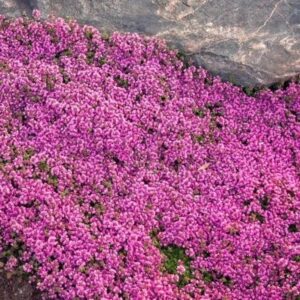About Red Creeping Thyme
Red Creeping Thyme (Thymus serpyllum), also known as Mother of Thyme, is a versatile and low-maintenance ground cover perfect for Oklahoma gardens. This hardy perennial offers a beautiful carpet of tiny, aromatic leaves and vibrant red flowers, making it an excellent choice for adding color and fragrance to your landscape. In this guide, we’ll cover everything you need to know about growing Red Creeping Thyme in Oklahoma, including its benefits and drawbacks, ideal growing zones, planting times, and care tips.

Pros And Cons Of Red Creeping Thyme
Pros:
1. Aesthetic Appeal: The bright red flowers and lush green foliage create a visually appealing ground cover.
2. Aromatic: When crushed or walked upon, the plant emits a pleasant thyme fragrance.
3. Drought-Tolerant: Red Creeping Thyme is highly drought-resistant, making it ideal for Oklahoma’s hot, dry summers.
4. Low Maintenance: Once established, this plant requires minimal care.
5. Erosion Control: Its dense growth habit helps prevent soil erosion on slopes and hillsides.
6. Pollinator Friendly: The flowers attract bees and other pollinators, promoting a healthy garden ecosystem.
7. Versatile Uses: Can be used in rock gardens, between stepping stones, or as a lawn substitute.
Cons
1. Slow Growth: It may take a couple of seasons to fully establish and cover the desired area.2. Not Ideal for Heavy Foot Traffic: While it can tolerate light traffic, it’s not suitable for areas with heavy footfall.
3. Limited Shade Tolerance: Prefers full sun and may not thrive in shaded areas.
4. Susceptible to Overwatering: Requires well-draining soil to prevent root rot.
Ideal Growing Zones
Red Creeping Thyme is hardy in USDA zones 4-9. Oklahoma, which falls within zones 6-8, provides a suitable climate for growing this plant. The mild winters and hot summers in Oklahoma align well with the plant’s growth requirements.
When to Plant Red Creeping Thyme
The best time to plant Red Creeping Thyme in Oklahoma is in the spring after the last frost date or in the fall before the first frost. This allows the plant to establish its roots before the extreme temperatures of summer or winter.
Planting and Care Tips
1. Soil Requirements: Red Creeping Thyme prefers well-draining soil with a pH between 6.0 and 8.0. Amend heavy clay soils with organic matter to improve drainage.
2. Sunlight: Plant in an area that receives full sun for at least 6-8 hours a day.
3. Planting: Space plants about 12-18 inches apart to allow for spreading. Dig holes that are twice the width of the root ball and the same depth.
4. Watering: Water thoroughly after planting and keep the soil slightly moist until the plants are established. Once established, reduce watering frequency, allowing the soil to dry out between waterings.
5. Mulching: Apply a light layer of mulch to help retain moisture and suppress weeds, but avoid covering the crown of the plant.
6. Pruning: Trim back the plant after flowering to maintain its shape and encourage new growth.
7. Fertilization: Fertilize lightly in the spring with a balanced, slow-release fertilizer.
Resources for Growing Red Creeping Thyme in Oklahoma
Oklahoma State University Extension: Offers a wealth of information on gardening and plant care specific to Oklahoma. Visit their website for detailed guides and resources.
USDA Plant Hardiness Zone Map: Check your specific growing zone in Oklahoma using the USDA interactive map.
Oklahoma Gardening: A helpful website with tips and advice on all aspects of gardening in Oklahoma.
Conclusion
Red Creeping Thyme is an excellent choice for gardeners in Oklahoma looking for a low-maintenance, drought-tolerant ground cover that adds beauty and fragrance to their landscape. By following the tips and guidelines in this guide, you can successfully grow and enjoy this versatile plant in your garden. For high-quality Red Creeping Thyme plants, consider purchasing from Midwest Propagation Nursery, a trusted source for healthy and robust plants suited to the Oklahoma climate. Check out our full selection of perennials and ground cover.
